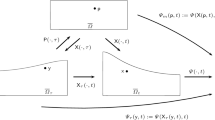Abstract
In this paper, the application of the meshless finite point method (FPM) to solve elastodynamic problems through an explicit velocity–Verlet time integration method is investigated. Strong form-based methods, such as the FPM, are generally less stable and accurate in terms of satisfaction of Neumann boundary conditions than weak form-based methods. This is due to the fact that in such types of methods, Neumann boundary conditions must be imposed by a series of equations which are different from the governing equations in the problem domain. In this paper, keeping all the advantages of FPM in terms of simplicity and efficiency, a new simple strategy for proper satisfaction of Neumann boundary conditions in time for elastodynamic problems is investigated. The method is described in detail, and several numerical examples are presented. Moreover, the accuracy of the method with reference to the solution of some 3D problems is discussed.
Similar content being viewed by others
References
AMGCL C++ library. https://github.com/ddemidov/amgcl. Accessed 11 Feb 2017
Bajko, J., Čermák, L., Jícha, M.: High order finite point method for the solution to the sound propagation problems. Comput. Methods Appl. Mech. Eng. 280, 157–175 (2014)
Belytschko, T., Lu, Y.Y., Gu, L.: Element-free Galerkin methods. Int. J. Numer. Methods Eng. 37(2), 229–256 (1994)
Boroomand, B., Najjar, M., Oñate, E.: The generalized finite point method. Comput. Mech. 44(2), 173–190 (2009)
Boroomand, B., Tabatabaei, A.A., Oñate, E.: Simple modifications for stabilization of the finite point method. Int. J. Numer. Methods Eng. 63(3), 351–379 (2005)
Dai, B., Wang, Q., Zhang, W., Wang, L.: The complex variable meshless local Petrov–Galerkin method for elastodynamic problems. Appl. Math. Comput. 243, 311–321 (2014). doi:10.1016/j.amc.2014.05.123
Fang, J., Parriaux, A.: A regularized Lagrangian finite point method for the simulation of incompressible viscous flows. J. Comput. Phys. 227(20), 8894–8908 (2008)
Giunta, G., Belouettar, S., Ferreira, A.J.M.: A static analysis of three-dimensional functionally graded beams by hierarchical modelling and a collocation meshless solution method. Acta Mech. 227(4), 969–991 (2016). doi:10.1007/s00707-015-1503-3
Hsieh, P.W., Shih, Y., Yang, S.Y.: A tailored finite point method for solving steady MHD duct flow problems with boundary layers. Commun. Comput. Phys. 10(01), 161–182 (2011)
La Rocca, A., Power, H.: A double boundary collocation hermitian approach for the solution of steady state convection–diffusion problems. Comput. Math. Appl. 55(9), 1950–1960 (2008)
Liszka, T., Duarte, C., Tworzydlo, W.: hp-Meshless cloud method. Comput. Methods Appl. Mech. Eng. 139(1–4), 263–288 (1996)
Liu, G., Gu, Y.: A meshfree method: meshfree weak–strong (mws) form method, for 2-d solids. Comput. Mech. 33(1), 2–14 (2003)
Liu, G., Wu, Y., Ding, H.: Meshfree weak–strong (mws) form method and its application to incompressible flow problems. Int. J. Numer. Meth. Fluids 46(10), 1025–1047 (2004)
Liu, G.R.: Mesh Free Methods: Moving Beyond the Finite Element Method. Taylor & Francis, London (2010)
Mirzaei, D., Hasanpour, K.: Direct meshless local Petrov–Galerkin method for elastodynamic analysis. Acta Mech. 227(3), 619–632 (2016). doi:10.1007/s00707-015-1494-0
Mossaiby, F., Ghaderian, M.: A preliminary study on the meshless local exponential basis functions method for nonlinear and variable coefficient pdes. Eng. Comput. 33(8), 2238–2263 (2016)
Nguyen, V.P., Rabczuk, T., Bordas, S., Duflot, M.: Meshless methods: a review and computer implementation aspects. Math. Comput. Simul. 79(3), 763–813 (2008)
Oñate, E.: Derivation of stabilized equations for numerical solution of advective–diffusive transport and fluid flow problems. Comput. Methods Appl. Mech. Eng. 151(1–2), 233–265 (1998)
Oñate, E., Idelsohn, S., Zienkiewicz, O.C., Taylor, R.L.: A finite point method in computational mechanics. Applications to convective transport and fluid flow. Int. J. Numer. Methods Eng. 39(22), 3839–3866 (1996)
Oñate, E., Perazzo, F., Miquel, J.: A finite point method for elasticity problems. Comput. Struct. 79(22–25), 2151–2163 (2001)
Ortega, E., Oñate, E., Idelsohn, S.: An improved finite point method for tridimensional potential flows. Comput. Mech. 40(6), 949–963 (2007)
Sadeghirad, A., Kani, I.M.: Modified equilibrium on line method for imposition of neumann boundary conditions in meshless collocation methods. Int. J. Numer. Methods Biomed. Eng. 25(2), 147–171 (2009)
Sadeghirad, A., Mohammadi, S.: Equilibrium on line method (ELM) for imposition of Neumann boundary conditions in the finite point method (FPM). Int. J. Numer. Methods Eng. 69(1), 60–86 (2007)
Shojaei, A., Boroomand, B., Mossaiby, F.: A simple meshless method for challenging engineering problems. Eng. Comput. 32(6), 1567–1600 (2015)
Shojaei, A., Boroomand, B., Soleimanifar, E.: A meshless method for unbounded acoustic problems. J. Acoust. Soc. Am. 139(5), 2613–2623 (2016)
Shojaei, A., Mudric, T., Zaccariotto, M., Galvanetto, U.: A coupled meshless finite point/peridynamic method for 2d dynamic fracture analysis. Int. J. Mech. Sci. 119, 419–431 (2016)
Shu, C., Ding, H., Yeo, K.: Local radial basis function-based differential quadrature method and its application to solve two-dimensional incompressible Navier–Stokes equations. Comput. Methods Appl. Mech. Eng. 192(7), 941–954 (2003)
Tatari, M., Kamranian, M., Dehghan, M.: The finite point method for the p-Laplace equation. Comput. Mech. 48(6), 689–697 (2011)
Weaver Jr., W., Timoshenko, S.P., Young, D.H.: Vibration Problems in Engineering. Wiley, New York (1990)
Wu, N.J., Chen, B.S., Tsay, T.K.: A review on the modified finite point method. Math. Probl. Eng. 2014, 1–29 (2014)
Zhang, X., Song, K.Z., Lu, M.W., Liu, X.: Meshless methods based on collocation with radial basis functions. Comput. Mech. 26(4), 333–343 (2000)
Acknowledgements
The support of the ‘Visiting Scientist’ scheme of Padua university is gratefully acknowledged.
Author information
Authors and Affiliations
Corresponding author
Rights and permissions
About this article
Cite this article
Shojaei, A., Mossaiby, F., Zaccariotto, M. et al. The meshless finite point method for transient elastodynamic problems. Acta Mech 228, 3581–3593 (2017). https://doi.org/10.1007/s00707-017-1894-4
Received:
Revised:
Published:
Issue Date:
DOI: https://doi.org/10.1007/s00707-017-1894-4




